
Not sure I would personally wear these, but an A+ for Black Milk‘s creativity with these Yip Yip leggings.
Below, an oldie but goodie: Yip Yips get all gangsta with “Ante Up” (NSFW):
Previously on Dangerous Minds:

Not sure I would personally wear these, but an A+ for Black Milk‘s creativity with these Yip Yip leggings.
Below, an oldie but goodie: Yip Yips get all gangsta with “Ante Up” (NSFW):
Previously on Dangerous Minds:
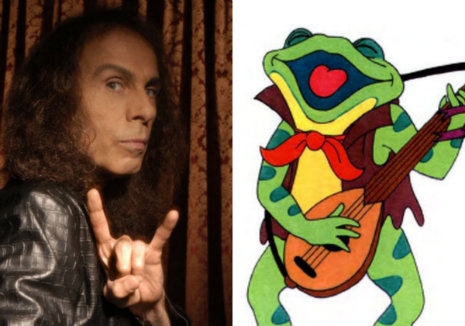
You learn something new every damned day. My TIL? Remember “The Butterfly Ball and the Grasshopper’s Feast,” that great cartoon many of you reading this—perhaps the majority, even, since it’s had such a very long shelf-life—will recall from when you were a kid? Why that’s Mister Ronnie James Dio hisself who was doing the frog’s singing.
Good god! (or “Hail Satan!” if you prefer) Imagine if the Christian Right would had known this at the time: The evil genius heavy metal master many say was personally responsible for introducing the “devil horns” salute into the culture was worming his evil way into the ears of millions upon millions of kids from 1976 onwards! What kind of backwards-masked Satanic subliminal messages were inserted into this childhood classic?
What will Alex Jones say when he hears about this???

Yesterday when I was posting about the CIA-funded animated Animal Farm, I did a search on the couple, John Halas and Joy Batchelor (”Halas and Batchelor” was the name of their revered production company) who made it, to see what else they had produced (short answer = tons of stuff) and I took particular note of one of them: The almost psychedelic animated short they made to accompany “Love is All,” a track from The Butterfly Ball and the Grasshopper’s Feast, an ambitious rock opera by Deep Purple’s Roger Glover and some of his famous friends. (When the show was staged—and filmed—for a one-off 1975 performance, the cast included members of Deep Purple, Twiggy, the guy who later played “Sgt. Apone” in Aliens and it was narrated by Vincent Price.)
The short film, part of what was intended to be a full-length project, was widely seen on television the world over for over fifteen years. In America, we saw it on The Electric Company and Nickelodeon from the 1970s well into the 1990s, and it was frequently seen in France, Australia, New Zealand, and especially in the Netherlands, where the song went to #1 and evokes such strong childhood associations that the Christian Democrats used the cheerful ditty for their 2006 general campaign ads.
It was directed by Lee Mishkin and based on the work of famed illustrator Alan Aldridge, who had previously put out his own 1973 book (based on the famous poem by William Roscoe, one of history’s first abolitionists) that served as the inspiration for Glover’s project.
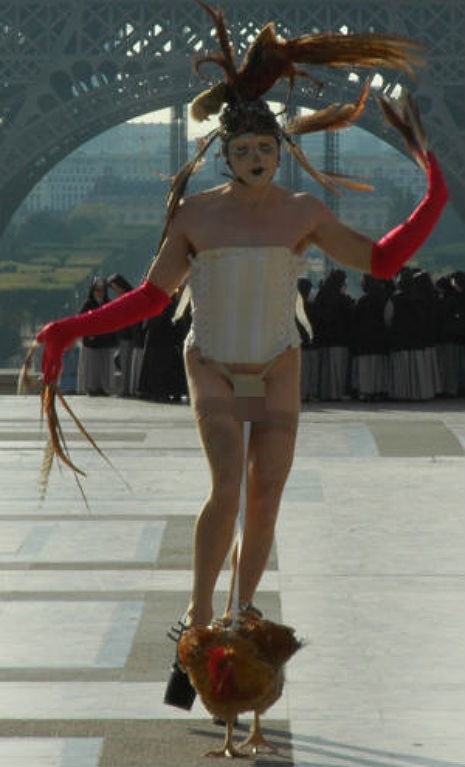
As one does, right? Looking like a cross between Leigh Bowery and a whacked-out Vegas showgirl, South African performance artist, Steven Cohen thought it would be a reasonable idea to dress in a bird-like costume with a rooster tied to his penis on a long ribbon and shimmy around the Eiffel Tower. Why not? Lots of reasons…
“He danced with the cock for around ten minutes, before being arrested by the police,” his lawyer Agnes Tricoire told French daily Le Parisien.
Cohen was held by Paris police on charges of indecent exposure.
His lawyer expressed her disgust with the duration of his arrest, telling Le Parisien: “It’s a disgrace. With this performance, Steven Cohen wanted to evoke his situation, split between two countries.”
“South Africa, his native land, and France, where he lives at the moment,” she explained. “France is throwing artists in prison,” she added.
Cohen was released Tuesday evening and is expected to appear in court on December 16th.
Sadly, there is no video evidence.
Via Arbroath

Some people are calling shenanigans on this epic customer service meltdown uploaded to YouTube yesterday (by a person claiming to be a former employee of the company). A lot of folks are chiming in the YouTube thread saying anyone claiming this is “fake” has never worked in a call center. Apparently this is the crap they have to deal with all the time. Nothing new.
Things get real nasty when the customer is put through to tech agent Mark. Poor Mark… It’s a total Falling Down moment.
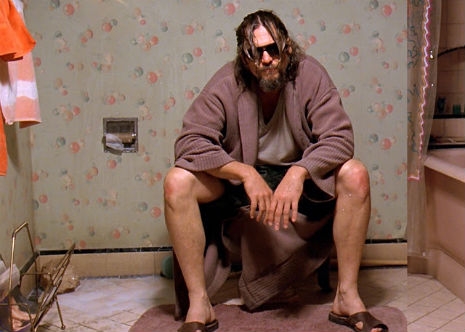
A few months ago Tara did a post on 1A4STUDIO’s brilliant 60-second version of Terry Gilliam’s Fear and Loathing in Las Vegas—in doing so she remarked that “One of the YouTube commenters is asking for a minute-long version of The Big Lebowski. That would be good, too.”
I’m happy to report that 1A4STUDIO has followed through on Tara’s request—and it’s far better than the Fear and Loathing in Las Vegas one, in my opinion. The entry of Maude Lebowski is pretty fucking fantastic, as is the Valkyrie bowling dream sequence and the scene where the nihilists dump a ferret into The Dude’s bathtub.
So, so, so good.
Previously on Dangerous Minds:
Amusing ‘The Big Lebowski’ poster starring Frank Zappa, Iggy and Bowie
‘The Big Lebowski’ bowls a strike with Quincy Jones’ ‘The Dude’
The Big Lebowski toilet set
Minute-long ‘Fear and Loathing in Las Vegas’ is a 60-second drug binge

I don’t know who the hell Wes Naman is or how he came up with this crazy idea, but the results speak for themselves. The freakishly distorted visages of his curiously likable bunch of rebellious chums—well, I won’t forget them for quite some time. I wonder what they “really” look like…..




I think Naman has really stumbled onto something here—can this become a thing, please?
See more of these startling pics at Naman’s website.
Previously on Dangerous Minds:
100 tiny portraits of Vincent Price
Portrait of Serge Gainsbourg made from 20,000 cigarette butts
Amy Winehouse portrait done in pills by Jason Mecier
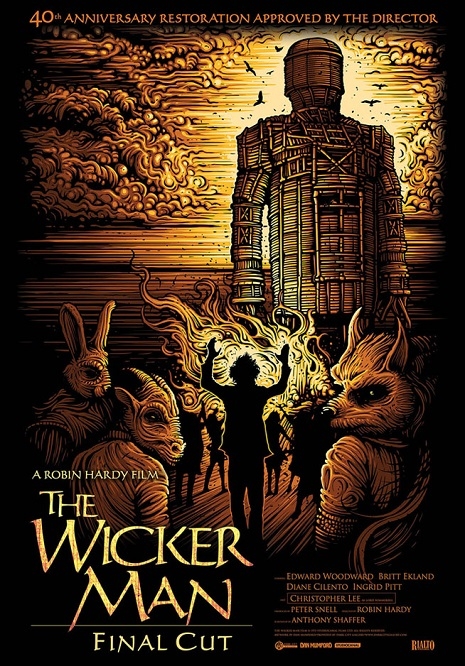
The definitive version of ‘70s cult classic The Wicker Man will be released later this month in a new beautiful digital restoration. Using a 35mm print that was recently discovered at the Harvard Film Archive, this restored final cut of the film has been approved by its director, Robin Hardy, as the one that, in his words, “fulfills my vision.” The unauthorized version released back in 1973 was mutilated by its original distributor and is the movie that most of us are familiar with. So, this resurrected edition really should be an eye-opener for fans and novices alike.
The unmolested print of The Wicker Man was discovered via a Facebook campaign launched by the film’s current worldwide rights holder Studiocanal. Other than re-introducing me to an old flame that eventually became my wife, this is about the grooviest thing Facebook has done for me personally.
The film’s press release offers some details:
Butchered by its doomed UK distributor to fit on double bills, with its original camera negative apparently lost, THE WICKER MAN has gathered a devoted fan base over the past four decades. Some missing scenes were recovered from an obsolete one-inch broadcast tape, but over the years there were rumors of complete 35mm prints floating around.
Earlier this year, the search intensified when worldwide rights holder Studiocanal initiated a Facebook campaign to recover the missing 35mm material, resulting in the discovery of a 92-minute 35mm release print at the Harvard Film Archive. This print was scanned and sent to London, where it was recently inspected by director Robin Hardy, who confirmed that it was the same cut he had put together for its American distributor in 1979, years after the film’s UK bow. This culminated in a digital restoration of the complete U.S. theatrical version, which director Hardy recently anointed as “the final cut.”
The Wicker Man will be opening Friday, September 27 at IFC Center in NY, Nuart in LA, and national release to follow. Thanks to Rialto distribution for getting behind it and getting it out there.
Here’s a clip from the restored version:
The extraordinarily cool poster is by artist Dan Mumford.

When William S. Burroughs’ novella “Ah Pook Is Here” was published in 1979, it was in a form greatly diminished from the authors’ original intent. That’s not a typo, because although it was Burroughs who wrote the text that was published, there were two creators of the far more elaborate work that it was cleaved from, Burroughs and Malcolm McNeill, a then 23-year-old illustrator.
Burroughs’ apocalyptic text tells the story of a megalomaniac bastard (an “Ugly American” based on a powerful media tycoon like William Randolph Hearst or Henry Luce) who acquires the powers of the Mayan death god, Ah Puch. Conceived as “continuous panorama,” with accordion-style, linked pages in the pictographic format of the surviving Mayan codices—“an early comic book” as per Burroughs—the project, seven years in the making, consisted of over 100 detailed illustrations by McNeill, 30 in full color, and about 50 pages of text. “Ah Puch is Here” (as it was originally titled) would have been prohibitively expensive to publish at the time, but it was also rather racy and sexually explicit—including male on male imagery—meaning the pool of potential publishers was certainly very, very small to begin with.
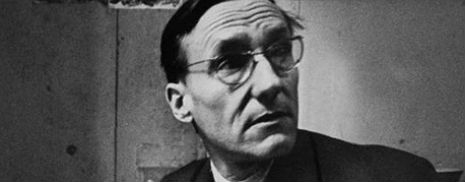
As Burroughs wrote in the forward to the 1979 book:
“[O]ver the years of our collaboration Malcolm McNeill produced more than a hundred pages of artwork. However, owing partly to the expense of full color reproduction, and because the book falls into neither the category of the conventional illustrated book, nor that of a comix publication, there have been difficulties with the arrangements for the complete work. The book is in fact unique…”
That it was. “Ah Puch is Here” wouldn’t have been the first graphic novel—Burroughs’ own American publisher Grove Press had already put out Guy Peellaert and Pierre Barther’s Adventures of Jodelle as well as Massins’ graphic interpretation of Ionesco’s The Bald Soprano... There was Jean-Claude Forest’s Barbarella, Michael O’Donoghue’s The Adventures of Phoebe Zeit-Geist, Guido Crepax’s “Valentina” series, The Adventures of Tintin, lots of stuff comes to mind, but in the main these books were collections of episodic comic strips, not “serious” narratives originally conceived of to fit between two book covers or that would have required luxurious glossy printing to properly display the highly detailed Hieronymous Bosch-inspired photorealistic artwork within… Unique yes, then as now.
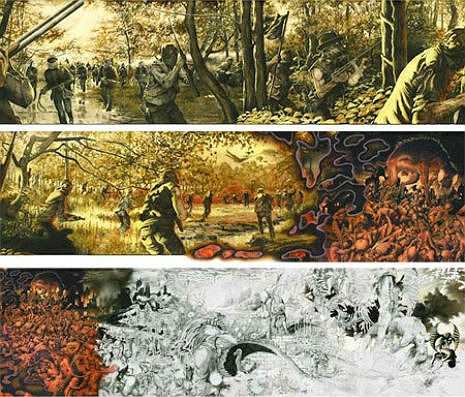
Burroughs collaboration with McNeill began in 1970, when the author was living in London and McNeill was an art student. Without any communication between them, McNeil illustrated Burroughs’ submissions to Cyclops magazine, “The Unspeakable Mr. Hart” and impressed him enough so that he wanted to meet the young artist. (It’s worth noting that McNeil scarcely had any idea who Burroughs was at the time, even so, he drew Mr. Hart, the villain, to look a lot like a younger version of El Hombre Invisible.)
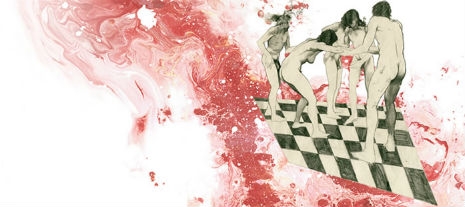
After a year of museum research and preliminary design on a mockup, Rolling Stone’s Straight Arrow Books imprint agreed to publish the “Ah Puch” book and McNeil moved to San Francisco to work on it. Straight Arrow was shuttered in 1974 and eventually the project was abandoned before the text portion alone saw the light of day in Ah Pook Is Here and Other Texts in 1979. Malcolm McNeil went on to a distinguished career as an illustrator for the likes of National Lampoon, Marvel Comics and The New York Times and a motion graphics designer and director for film, advertising and television, including winning an Emmy for his work for Saturday Night Live. (This will be of interest to no one save for fellow vets of the 1980s New York advertising world, but McNeil’s Paintbox work was synonymous with Charlex, the NYC-based video production house probably best known for The Cars’ “You Might Think” video, dozens of TV show openings and hundreds of commercials.)
After some 30 years in storage, the by now fragile “Ah Puck is Here” artwork was restored by Malcolm McNeill for exhibition, and was shown at Track 16 Gallery in Santa Monica, CA, the Saloman Arts Gallery in Manhattan and elsewhere.
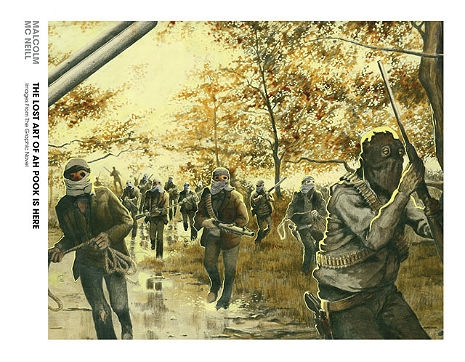
Fantagraphics have published two separate Ah Pook books, one a gorgeous coffee table book of McNeil’s extraordinary panoramic illustrations for the Burroughs collaboration, The Lost Art of Ah Pook Is Here: Images from the Graphic Novel and a memoir, Observed While Falling: Bill Burroughs, Ah Pook, and Me, an intimate, affectionate portrait of their unlikely friendship and multi-year/multi-continent joint project.
The first book has very little text, and although it’s impossible to make heads or tails out of what is going on with the drawings alone, trust me, you get a very good sense of the epicness of the vision and also see some of what would have made 99% of the publishers of the 1970s very squeamish. Sadly, for reasons McNeil politely declines to go too far in-depth about, he was denied the use of Burroughs’ text for the Fantagraphics publication by his estate and this is a real shame.
However, if you have a copy of truncated 1979 Ah Pook Is Here (I do) it becomes an even more satisfying excuse to dive in deeply on the detective work and match passages from the text to the artwork. If you’re interested enough to purchase the coffee table book, surely you are going to have to rush over to eBay or ABEBooks and get yourself a copy of Ah Pook Is Here and Other Texts, just bear that in mind.

Observed While Falling: Bill Burroughs, Ah Pook, and Me, the memoir and the third book in this trilogy, is no less essential for anyone seeking a deeper understanding of what made Burroughs tick, and should, along with the artwork that was regretfully parted from WSB’s text, be seen as one of the most exciting things to come along in Burroughs scholarship in recent years. It is, by far, the most observational—and highly personal/subjective, which makes it fun—look at Burroughs produced by any of his friends or collaborators. McNeil is a fine writer—the man must be a superb raconteur—and he never forgets who the book is really about.
I must say, as a longtime William Burroughs fanatic, I was wowed by McNeil’s twinned Fantagraphics books (which are beautiful matching objects) and spellbound by his tales of working with Burroughs. There are really three books here that you need, so it’s not a cheap proposition to acquire the lot, but if you’re a big Burroughs fanboy, it’s certainly well worth the expense.
Furthermore, if you’re so inclined Malcolm McNeil is selling very reasonably priced limited edition prints of several of his incredible “Ah Pook” panels.

The Dead City Radio recording of Burroughs reading “Ah Puck is Here” provides the soundtrack to this amazing short animated film directed by Philip Hunt with music by John Cale.
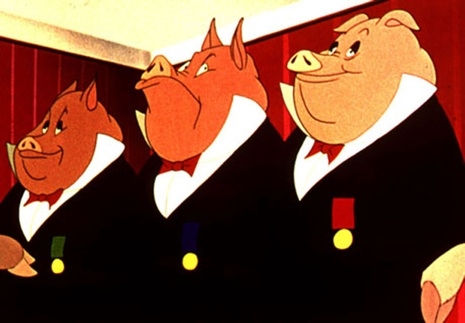
Until videotapes replaced 16mm film projectors in the classroom in the mid-1980s, there was a very good chance that if you were British or American, that at least once, if not twice or more, you were going to see the animated 1954 version of George Orwell’s Animal Farm during your education. I can vividly recall being absolutely incredulous during a post-film discussion in high school, that the teacher we had seemed to have no idea, as in none at all, that Animal Farm was quite specifically a satire of the Russian revolution and the rise of Joseph Stalin. After I raised my hand to object and explained, no doubt with the cocky annoyance of a teenaged autodidact, that “Old Major” was a Karl Marx/Lenin figure, that “Napoleon” was Stalin, “Snowball” was Trotsky and so forth, she blithely dismissed what I said (she clearly had no idea of what I was talking about and so therefore had nothing to add) and remarked that “it could be one theory.”
No my dear, that would be the only fuckin’ theory. If you think American public schools are bad now, I put it to you that they’ve always been pretty shitty…
Animal Farm was directed by the husband and wife animation team of John Halas and Joy Batchelor. It is considered one of the greatest British films, something akin to a “serious” work from Disney. The film does not follow the events of the book very closely, especially the “hopeful” ending that Halas felt necessary to tack on. Orwell’s book ends with the animals numbly resigned to their exploitation by the porcine politburo in cahoots with the humans. This was considered too bleak and Halas wanted an upbeat ending. “You cannot send home millions in the audience being puzzled,” he said about the film in 1980.
But there is an interesting back story of how Animal Farm came to be made that most people are probably unaware of: The most famous British animated film ever made was in fact financed by the American CIA in an effort to encourage a negative view of the Soviet Union.
In 1951, using American taxpayer dollars, the CIA’s Office of Policy Coordination carried out obtaining the rights to the book from Sonia Orwell, the author’s widow, in an operation run by future Watergate criminal E. Howard Hunt. Two members of the Psychological Warfare Workshop staff who were working in undercover in Hollywood made the arrangements. To thank Mrs. Orwell, the CIA arranged for her to meet actor Clark Gable.
Hunt chose as the film’s producer, Louis De Rochemont, the creator of the famed “March of Time” newsreel journalism films and De Rochemont had final say over all creative matters (Hunt worked for De Rochemont when he was younger). Over 80 animators worked on the film, including three Disney animators who were not credited, probably because they didn’t want to piss off Uncle Walt. Two of them went on to work on Yellow Submarine and Watership Down.
Vivien Halas, the daughter of the film’s directors, believes that her parents were innocent of knowing that the CIA was involved with the project:
“I don’t believe that my parents were aware of any CIA involvement at the time. Frances reminded me that, in the early 1950s, the CIA was not regarded with the same scorn as today. My father dismissed the idea, but my mother felt annoyed.” John Halas and Joy Batchelor would go on to do the Jackson 5ive and The Osmonds cartoons. Louis De Rochemont became paranoid about the CIA bugging him late in his life.
The film was completed in 1954 and distributed worldwide the following year, the first British animated feature ever to be so widely seen. Prints were made for schools and libraries the world over by the United States Information Agency (USIA). If you are over the age of 35 and saw the film in school, there is a very high likelihood that US taxpayer’s dollars paid for the print you saw. The animated Animal Farm, due to the whole “pigs are unclean” thing, was also thought to be effective anti-Soviet propaganda in the Middle East.
On the flip-side, the Soviet spin on Orwell’s 1984 is that the book’s nightmarish depiction of constant state surveillance was about everyday life in America.
This is all so Orwellian, it’s making my head spin…
Read the full story in Orwell Subverted: The CIA and the Filming of Animal Farm
The cartoon that came in from the cold (The Guardian)
How Big Brothers used Orwell to fight the cold war (The Guardian)

This is a guest post by Stephen W Parsons
Alexis Korner, born 1928, died 1984, was a minor figure on the British jazz, blues and rock scene but a major influence on many of its young players as they were hungrily transforming themselves into superstars. He was a middling talent at best with a limited musical ability redeemed by, when on pitch, a warm husky voice and an engaging performance persona, which remained patently intact both off-stage and on. The voice was indeed a seductive instrument and in later years it opened the door to lucrative voiceovers for commercials and work as a presenter on both Radio and TV. My first memory of the man was as the leader of a shabby-looking house band, who played in a cardboard cabin on a children’s show called 5 O’ Clock Club.
Wikipedia, well-researched books on the period and general critical opinion are all agreed that Korner was a “founding father of British blues music,” an all around good guy and a beneficial mentor to emerging talent.
I beg to differ but before we get to the murky heart of the matter, the casualty list, and the body count, we must examine the historical set and setting.
You may think, from the 21st Century perspective, that the ‘British Blues Boom’ of the 1960s and 70s was simply a genre “of its time” like swing music or punk. This would be a severe underestimation of its latent vitality. Crinkly veterans such as The Rolling Stones are carving out substantial profits and Fleetwood Mac, which still contains three stalwarts of the Brit blues explosion, is on its way back to the marketplace in a big way. Industry analysts estimate that, were Led Zeppelin to reform tomorrow and an announce a 24 date world tour, the combined earnings of such a venture and its concurrent media heat would cast a long shadow over the current crop of musical superstars such as Jay-Z, One Direction, Adele or Mumford and Sons.
Alexis Korner, inadvertently, played a small part in the development of the mighty Led Zeppelin. He discovered Robert Plant during the Summer of Love and decided to build a musical venture around the handsome and talented young performer. They formed a duo and Korner decided to self-finance an album. Only two tracks were recorded before wild fate intervened. Jimmy Page, having just been rebuffed by the supremely talented Terry Reid, was searching for a singer to front The New Yardbirds, and intervened with a better offer. The two songs recorded by Korner and Plant, “Steal Away” and “Operator” are in circulation and demonstrate the wisdom of Plant’s career choice. Terry developed into a fine musical talent but never hit the heights, or the record sales, of his teenage years. He always claims that he doesn’t regret joining the proto Led Zeppelin – but I’ll bet that he does.
Alexis Korner did eventually receive a rather odd payoff from this particular setback. In 1975 his outfit the Collective Consciousness Society, a group comprised of top British session players and produced by pop supremo Mickie Most, recorded a corny big band-style instrumental version of the Led Zeppelin/Willie Dixon song “Whole Lotta Love.” It was picked up as a theme tune for the BBC’s premier British chart show and went on to become his biggest hit. He neither sang, nor performed on the track.
The story of the all embracing blues room, and in particular the Alexis corner of it, raises an obvious question mark which must be answered: How in the hell did the anguished wail of hoodoo blues crawl its way from the Nile Delta of antiquity into the dreams of middle class, suburban British teenagers during the middle of the 20th century?
Vooudon prophet M. Bertiaux and inspired musicians such as Sun Ra, Pharaoh Saunders and Lee “Scratch” Perry all refer obliquely to the Afro-Atlantian tradition, by which they mean that a thing of great value was carried by the Nubian slaves on their flight from Egypt. It was something invisible and intangible, yet it provided an inner source of vitality and a succour to sweeten the hardships endured while escaping from captivity. The technical name for the expression of this spirit is Misraim.
We know it as the blues.
It came to America with the slaves and put down roots in the plantations, then spread to the carnivals and juke joints and finally blossomed into jazz. Wherever there was a need for low-down, dirty music—the blues was always present. After the Second World War, African-Americans began to lose the taste for it. By the mid 1950’s they were looking for upbeat entertainment that didn’t stink of the cotton fields. Dirt music had spread its wings from the South to Chicago and found a temple at Chess Records. While upscale “colored” entertainers such as Louis Armstrong and the ruthless Nat King Cole were busy courting the white audience, blues masters such as Muddy Waters, BB King and Howling Wolf were producing startling music for a declining audience. As the decade came to a close they were reduced to eking out a living on the Chitlin’ Circuit, which was as appetizing as it sounds. They stared in stupefied amazement at young kids named Elvis and Buddy Holly who were aping their stage personas and shook their heads at newcomers from their own side of the fence such as Chuck Berry, Little Richard and Bo Diddley, who were going head to head with the white boys over this new-fangled hybrid thing called Rock and Roll.
What none of these people knew was that the blues had up and left.
One part of it flew straight into the hands of a Mr. Berry Gordy, who had recently been dreaming about using it to make something powerful, elegant and profitable like the cars that rolled off the streamlined Detroit conveyor belt.
The other part hitched a ride to Britain and Europe in the form of grooved shellac. American recordings were considered rare and precious gems in a drab, postwar Britain. The vibrant sounds of Armstong, Kid Ory and Bessie Smith were not available from the monopolistic state broadcaster. It was gramophones in otherwise sedate front room parlors that sparked a noisy revolution. “Trad” jazz bands and crude skiffle groups sprung up like a wildfire, taking the livelier end of the tradition into pubs, clubs and dance halls. It summoned a diverse crowd to these smoke-filled rooms: Left Wing ‘ban the bomb’ types, working class people who liked “a knees up,” earnest intellectuals, part-time bohemians and run down Aristocrats on the lookout for something new and slightly daring to tickle their jaded fancy.
There were those among them who began to search out, and value above all else, primitive field recordings by artists like the sublime Robert Johnson. Alexis Korner was an energetic and enthusiastic member of this elite group. It was here, right at the beginning of the development of British Blues, that an intellectual faultline occurred. A strange kind of inverted snobbery developed as to what exactly was “the real thing.”
Doubt had entered the blues room.
Of course the great apocryphal story on blues authenticity concerns Sleepy John Estes. He was one of the many great folk artists recorded ‘in the field’ by pioneer archivist Alan Lomax and when his sensuous recorded music began to gather followers, Lomax invited him to play at Carnegie Hall. It’s said that Sleepy John bought himself a sharp suit, an electric guitar and a two-piece band to accompany him when he hit the Big Apple. Unfortunately Lomax was concerned that this would compromise the naturalistic vision he was selling to the predominantly white audience. Sleepy John was convinced to dump the suit, the amplifier and the sidemen; put on a work shirt and sit on a bale of hay.
The notion of an archetypal purity in the dirt soon became a siren call across Britain attracting a new breed of audience members to the Alexis Korner shows: sincere young men with longer than average hair, a distinctive dress sense and a polite soft spoken manner.
One of them was Brian Jones.
TO BE CONTINUED…
This is a guest post by SWP aka Snips/Stephen W Parsons/Steve is the founder of the Scorpionics self-improvement system. He sang for various beat groups until 1982 and then pursued a more successful career as a composer for hire until 2004. Since then he has voyaged into peculiar seas. His latest musical adventure is The Presence LDN which will be releasing product in October 2013. His younger, and more handsome self can be seen singing with Ginger Baker here.
Below, Alexis Korner with Steve Marriott in 1975: